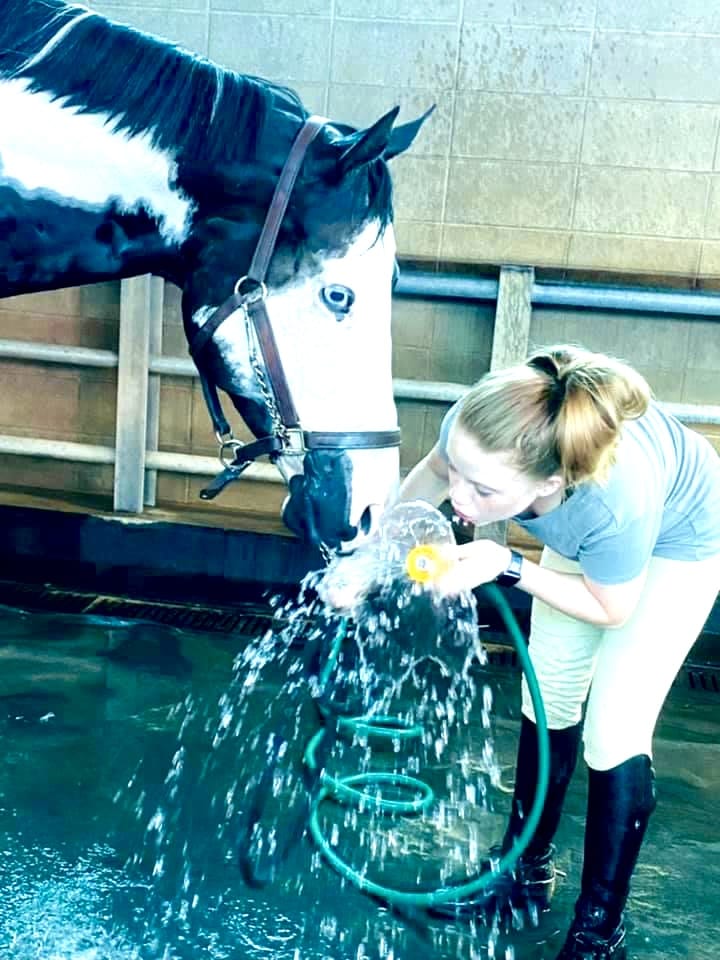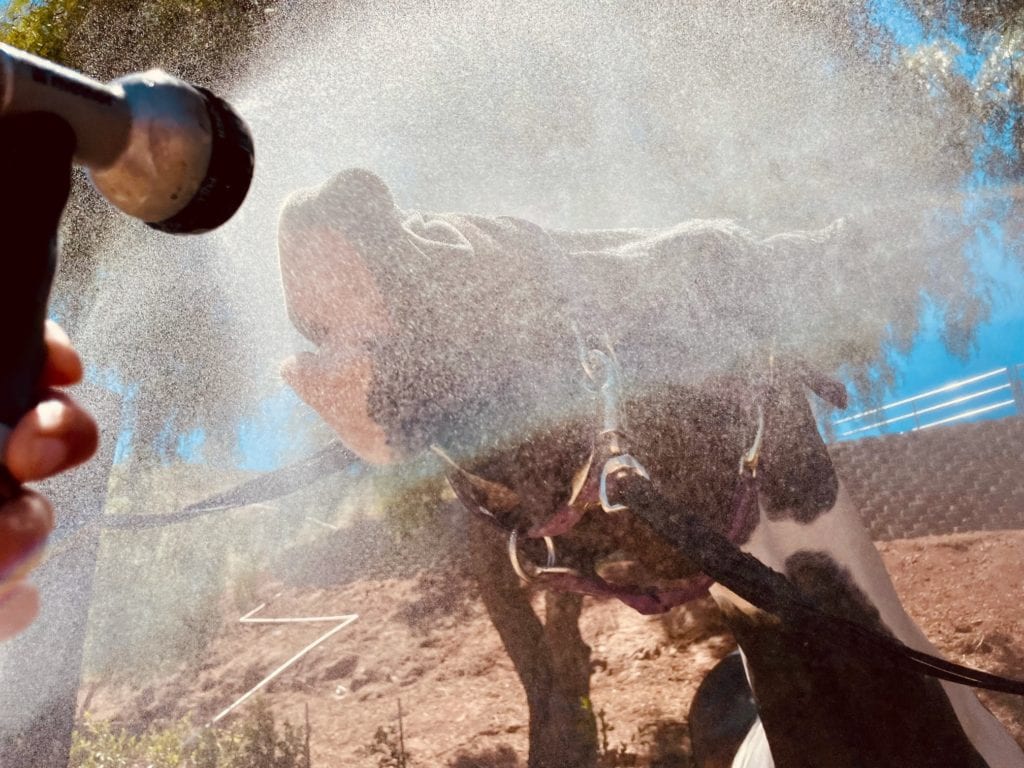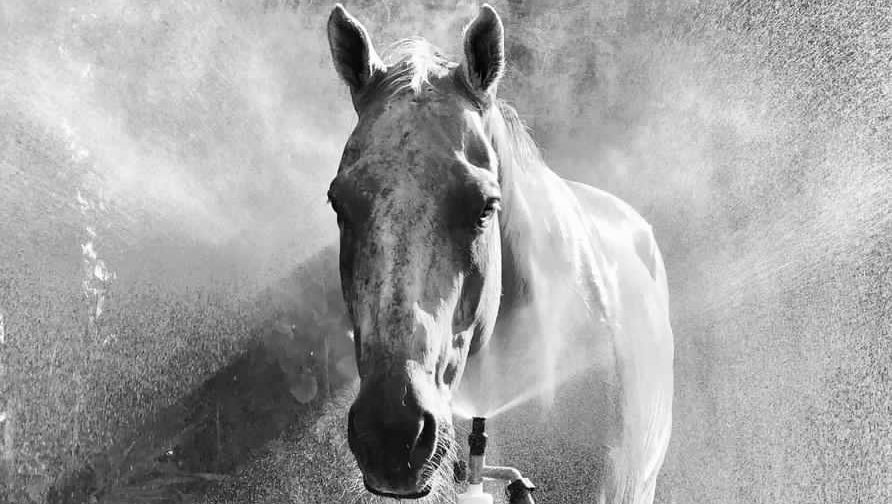It’s that time of year: the sun is out, the horses have shed their winter coats, and the flies have returned from the underworld. While more consistently warm temperatures allow more time for practice, they also require that we pay special attention to our equine partners to ensure they stay cool in the heat.
We’ve compiled conventional knowledge, veterinary advice, and some out-of-the-box hacks to help you keep your horse cool this summer. Of course, as with anything, if your horse is showing signs of colic, heat exhaustion, or heat stroke, make sure to contact a licensed veterinarian to perform an examination and recommend treatment. In the meantime, these six tips are great ways to keep your horses cool before a vet-worthy problem arises:
Hydration
 As with all creatures, the key to staying cool centers around adequate hydration. When the temperature heats up, a horse’s need for water increases exponentially. So, what can you do at home to help make sure your horse is getting enough water?
As with all creatures, the key to staying cool centers around adequate hydration. When the temperature heats up, a horse’s need for water increases exponentially. So, what can you do at home to help make sure your horse is getting enough water?
- Turn off automatic watering systems. While automatic waterers certainly help with convenience and allow horses access to water-on-demand, it can be challenging to determine whether your horse is drinking enough when temperatures soar. Turning off the automatic waterers and going back to the simple bucket system will allow you to keep a better eye on water intake. According to Penn State University, your horse should be drinking approximately 5-10 gallons of water per day.
- Add electrolytes to your horse’s diet. While many veterinarians recommend access to electrolytes year-round (primarily if the horse is being worked throughout the year), they are even more highly recommended during the summer months. This is because electrolytes serve a dual purpose in the summer, as they will help replace salt and minerals lost through sweating while encouraging your horse to drink more water.
- The Pinch Test. Penn State recommends a simple (although not consistently accurate) home test for determining whether your horse is dehydrated: pinch a fold of the horse’s skin and then release it. The skin should immediately return to its natural position. If the skin remains in a ridge from 2-5 seconds post-pinch, this could signify mild dehydration. The longer the skin remains in a ridge (i.e., 10-15 seconds) can indicate the level of severity of potential dehydration.
Access to Shade
Another vital way to make sure your horse stays cool is to ensure they have access to shade, which is especially important for horses with lots of pink skin which may burn easily. Some ways of keeping your horse out of the sun include:
- Add a lean-to or large trees to pastured areas.
- Keep your horse in a stall during the more sun-intense times of the day (nearly half of daily ultra-violet radiation is received between the hours of 10:00 am – 4:00 pm).
- Keep your horse in a stall.
Proper Ventilation
While keeping a horse stalled during the most intense sunlight hours (see above) can help keep them cool, this is useless if the stall is not adequately ventilated. Mid-day stalling can have the opposite effect if the stall doesn’t allow air to move freely through it. To avoid hot boxing your horse, do the following:
- Install fans that point directly at the stall. If installing more than one fan, it is helpful to point them in a manner that allows for a cross-wind.
- Open the barn doors.
- Open the stall door that allows the horse to hang their head out into the aisleway or outdoors.
Bathing and Misting
One sure-fire way to cool your horse down is by giving them a cool bath.
 A while back, a meme circulated online advising owners NEVER turn out a wet horse as the water acts as an insulator and can cause your horse’s temperature to rise when the sun warms the water. According to veterinarians, this warning is “somewhat” true. So if you are hosing your horse down because its temperature is elevated, this warning is accurate.
A while back, a meme circulated online advising owners NEVER turn out a wet horse as the water acts as an insulator and can cause your horse’s temperature to rise when the sun warms the water. According to veterinarians, this warning is “somewhat” true. So if you are hosing your horse down because its temperature is elevated, this warning is accurate.
In this instance, you should scrape the water off after the bath (mainly if you are already in a humid climate) to ensure the bath has the effect of cooling and not heating the horse. However, if the horse’s temperature is not already elevated, it is acceptable to turnout a wet horse (assuming you won’t cry when they roll in the dirt). When giving a bath, consider the following:
- Focus your cooling efforts on big muscle groups and areas where the veins run close to the skin.
- If the horse remains warm after the first hose down, scrape off the warm water and restart the process – their skin will naturally heat the water so a hot horse may need multiple baths.
- Another option is adding misters to the barn or allowing the horse to stand in front of a mister for a time. Caution: when using misters, make sure they do not make stall bedding soggy as that will do more damage to your horse’s feet than the potential cooling effect.
Plan Your Riding Times Carefully
While summer months are more comfortable for humans to ride, they can be more uncomfortable for your horse. Therefore, most veterinarians recommend adhering to the following guidelines for summer riding:
- As mentioned previously, the sun’s rays are most intense between 10:00 am and 4:00 pm. Therefore, it is best to ride in an indoor or covered arena during these sun-intense hours.
- If an indoor or covered arena is not available, keep exercise sessions to times when the sun is less intense.
- Additionally, if you must ride in the sun during more sun-intense hours, it is advised to keep sessions shorter and less challenging to allow your horse to remain as comfortable in the heat as possible.
- Make sure to have a longer cool out after a workout when the weather is hotter.
Stick to the Formula. Many experts advise using the following formula for determining whether it is too hot to ride: add the temperature in Fahrenheit together with the percentage of relative humidity. For example, if it is 80 degrees and the humidity is 60 percent, your number will be 140.
- Less than 130: Green light – go ahead and ride.
- 130-170: Yellow light – be careful. The heat and humidity will compromise your horse’s ability to cool itself.
- 170 or above: Red light – don’t ride. It only takes about 15 minutes of moderate exercise to raise your horse’s temperature to a dangerous level.
Cooling Hacks
 The internet is full of hacks for many life situations, and cooling off your horse is no exception. Here are some hacks we found interesting:
The internet is full of hacks for many life situations, and cooling off your horse is no exception. Here are some hacks we found interesting:
- Equine Cooling Wraps. There are various cooling wraps on the market that you can wet with cold water and wrap or drape on your horse’s body to cool down a targeted area quickly.
- Otter Pops. If you want to save on cooling wraps, wrap your horse’s legs with an otter pop pack and then perform a regular polo or vet wrap on top of the popsicles. The natural separation of the popsicles allows for them to wrap nicely around the leg, so long as the exterior wrap is not too tight. The pops will melt, but they will cool down legs quickly and work better for a horse that refuses to stand in an ice bucket.
- Cooling Sprays. There are various gel sprays on the market that are recommended for cooling a horse’s muscles down. (Please contact your veterinarian before applying a topical coolant other than water.)
- Giant Ice Cubes. Freeze gallon jugs full of water and add them to water troughs to act as giant ice cubes to keep troughs cool.
Remember, as it gets hotter, providing extra care for your horses will help reduce their stress, maintain their health and overall well-being, and hopefully save you from some expensive vet bills.









